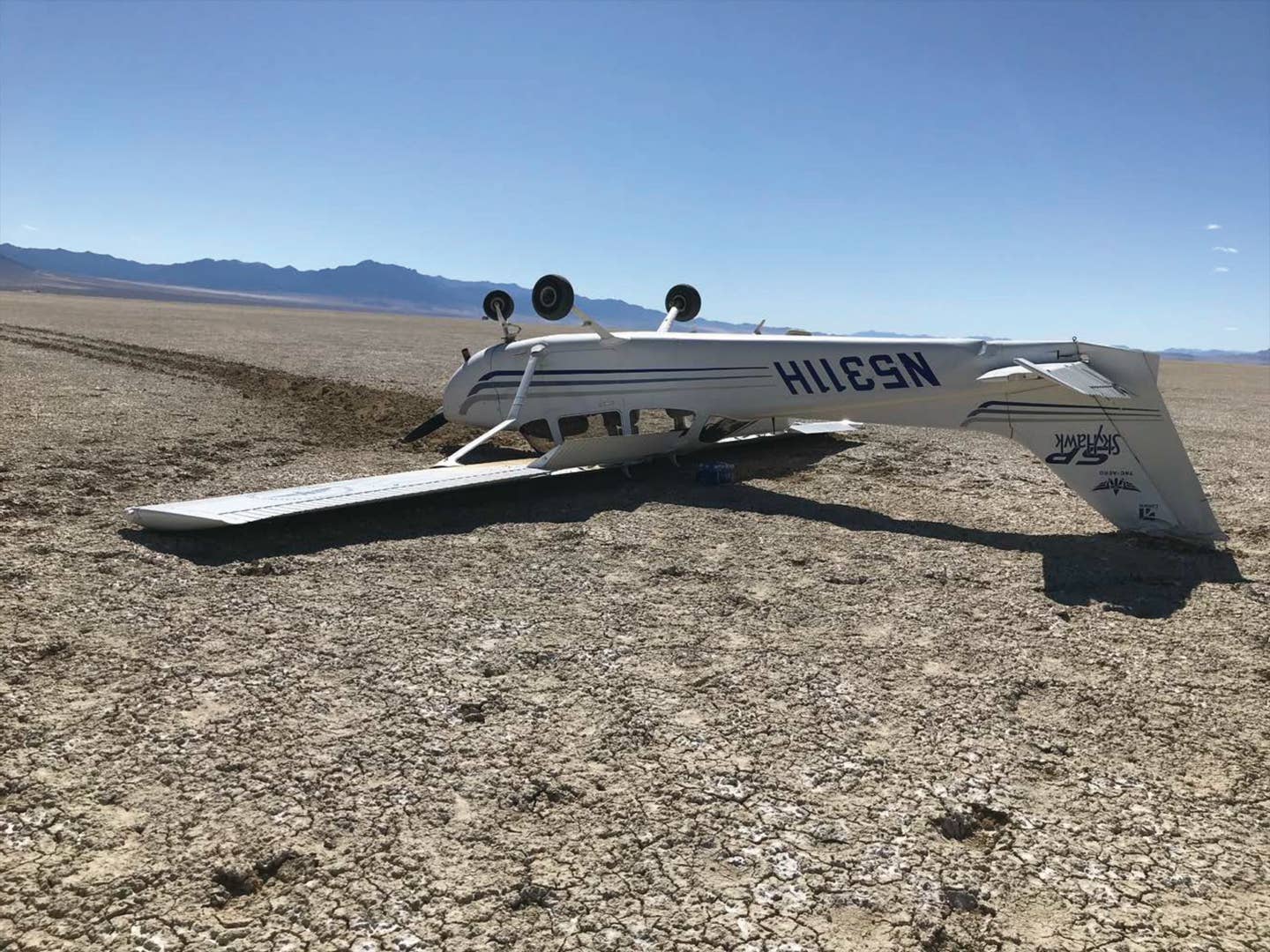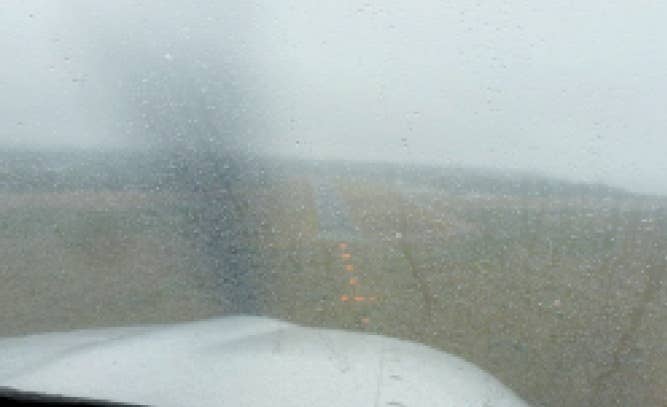Five Things You Can Break In A Pinch
If there’s one thing pilots are taught during their primary training, it’s to respect the limitations of the airplane they are flying. These can involve the detailed operating limits—especially airspeeds—found…

If there’s one thing pilots are taught during their primary training, it’s to respect the limitations of the airplane they are flying. These can involve the detailed operating limits—especially airspeeds—found in the airplane’s flight manual, demonstrated crosswind capabilities, loading configurations, prohibitions against flight in known icing...the list is seemingly endless. Those limitations exist for a variety of reasons—to ensure the airplane will meet performance expectations, that it won’t be damaged, and so it and the pilot comply with applicable regulations.
But there are times when, perhaps, we might want to exceed those limitations. I’m not talking about routine operations and how we might load the airplane outside of its weight-and-balance envelope, or perhaps intentionally wind up in icing conditions despite not flying something approved for them. Instead, I’m mainly thinking about abnormal situations—some of them may be extreme, full-blown emergencies—when bending or breaking some of the limitations under which we operate an airplane might be the only thing to get us home in one piece. As some wag once put it, “The operating limitations are only there in case another flight by that particular airplane is likely. If subsequent flights do not appear likely, there are no limits.”
Crosswind Component
Perhaps the most-violated limitation pilots face isn’t really a limitation at all. I’m thinking of the published maximum demonstrated crosswind value found in AFMs and POHs. It’s often thought of as a rule, or limitation, but it’s usually neither, depending on how the POH/AFM is written. Instead, it’s usually informational and merely advises that, during flight testing, the stiffest crosswind the test pilots were able to find was of the published value.
There are some FAA rules behind the maximum demonstrated crosswind component. For example, the agency requires a manufacturer to demonstrate, during the airplane’s type certification process, that it is controllable in 90-degree crosswinds up to 20 percent of VS0, the stall speed in the landing configuration. The test pilot flying it supposedly does not use exceptional skills to perform the demonstration. That’s it, and presuming the test pilot didn’t ding the airplane, the demonstrated crosswind component on that day appears in the POH/AFM. Can you exceed it, legally? Usually—unlike some other things you can do in an airplane that exceed its limitations or recommendations—and it can be relatively easy, especially if there’s plenty of runway length and width to work with (see the sidebar “Playing Crosswinds For Keeps” below).
Gear Extension Speed
A retractable-gear airplane’s maximum landing gear extended speed, VLE, and its maximum landing gear operation speed, VLO, are published for a reason. While it’s unlikely the gear itself would be damaged or ripped off if it was out in a breeze slightly above those limits, the same can’t be said for the landing gear doors. Too, operating in excess of these published speeds with extended gear could, indeed, result in them becoming unlocked, or place enough stress on the extension/retraction mechanism that repairs would be necessary. But landing is not the only thing we can do with landing gear.
They’re designed to retract because of their drag when extended. But that same drag can be useful to us in a pinch, when ATC leaves us too high and hot to make the runway, or we need to get down in a hurry, for example.
In non-emergency situations like that, it’s standard procedure among many pilots to slow the airplane in level flight to the point it decelerates below the VLO speed, then drop the gear, pull off some more power if necessary, and point the nose down. The additional drag of the extended landing gear will prevent us from building up too much speed while the rate of descent can be surprising. It’s not at all uncommon to see in excess of 2000 fpm down in a Bonanza with the gear out and reduced power, all of which is done at or below the VLO/ VLE speeds. That’s especially useful when extremely bad things like an in-flight fire is your concern, and you want to be on the ground five minutes ago.
Because of the drag it produces, extending the gear in extreme situations—like when the airplane is out of control and building speed into the yellow arc and beyond—can be part of your last-ditch attempt to recover. At that point, it won’t matter if the landing gear takes a beating, or a gear door departs the airframe—you need to do something to slow the airplane’s descent and regain control, right now.
Dropping the gear also has the benefit in many airplanes of shifting the center of gravity (CG), even if only slightly. Airplanes in otherwise unsurvivable spins have been recovered by the combined CG shift and increased drag of extending the landing gear to slow the airspeed and allow the pilot time to regain control.
Vertical Speed Indicator
Those of us flying around behind glass panels since birth may not even have a separate, “steamgauge” vertical speed indicator (VSI), but anyone who’s flown a round-dial airplane should be familiar with the instrument. Of the conventional six-pack of flight instruments, it’s the only one not legally required for IFR. In fact, the FAA, via the Pilot’s Handbook of Aeronautical Knowledge (PHAK, FAA-H-8083-25B), states, “If the VSI indicates anything other than zero, that indication can be referenced as the zero mark.” Why is this important? Because the VSI is one of those things on an airplane that can be intentionally broken to resolve a problem.
Elsewhere in the PHAK, the FAA notes, “In an aircraft not equipped with an alternate static source, an alternate method of introducing static pressure into the system should a blockage occur is to break the glass face of the VSI. This most likely renders the VSI inoperative. The reason for choosing the VSI as the instrument to break is that it is the least important static source instrument for flight.” Breaking the glass on the VSI bypasses the static-system blockage, and once again allows ambient pressure to be used by the airspeed indicator to measure the difference between it and the higher-pressure air flowing into the pitot tube, as well as “fixing” the altimeter.
Two things: One, and as the PHAK points out, the VSI likely won’t be usable once its glass face is broken. That’s okay, since we’d be needing a static source more than the VSI. The other thing is it might not be easy to break that glass—it’s not an iPad (although you could maybe use an iPad to break it). Some old-school pilots flying old-school airplanes carry a so-called “glass hammer,” which are popular with motorists who fear being trapped in their car after an accident. Glass hammers—see the sidebar “Break Glass In Case Of Emergency” below for an example—have a hard, sharp, metal head designed to break automotive glass and sometimes even feature a built-in seat-belt cutter. All in all, they’re not a bad thing to stash in your airplane’s glovebox, even if you don’t have a VSI.
The FARs
Another thing you can break in an emergency is the federal aviation regulations, or FARs. Here, also, the FAA has some specific guidance, ironically in a FAR—FAR 91.3, Responsibility and authority of the pilot in command, to be exact. Subsection (b) of 91.3 states, “In an in-flight emergency requiring immediate action, the pilot in command may deviate from any rule of this part to the extent required to meet that emergency.”
What does that mean? Well, at first blush, it means exactly what it says: You are allowed to break any regulation in an emergency, to the extent required to meet that emergency. Period. Of course, it really should be a bona fide emergency—you shouldn’t use 91.3(b) to bust the 250-knot speed limit below 10,000 feet because you forgot to go potty before takeoff.
What kinds of emergencies allow us to break a FAR? We’ve already discussed one of them, gear-extension speeds. Since we’re exceeding an airspeed limitation, we’re operating the airplane in contravention of FAR 91.9, Civil aircraft flight manual, marking, and placard requirements. Subsection (a) reads: “Except as provided in paragraph (d) of this section, no person may operate a civil aircraft without complying with the operating limitations specified in the approved Airplane or Rotorcraft Flight Manual, markings, and placards, or as otherwise prescribed....”
One question that sometimes comes up when discussing emergencies is its declaration. See the sidebar “Declaring The Emergency” below for some thoughts.
The Airframe
A final thing we can break in an emergency is the airframe. A classic example might be pulling the airframe parachute handle on aircraft equipped with them. That’s completely legal, by the way, since the airplane was type certificated or STC’d for the parachute and its deployment. (If you’re just trying to find a dramatic way to break a FAR, you’ll have to keep looking.) Another might be the aforementioned landing-gear extension, which in extreme situations is likely to break something. That having been said, I’m a strong advocate of sacrificing all or part of the airframe if doing so may enhance the occupants’ survivability.
Another classic example of what we’re discussing is the engine-failure scenario where there’s no chance to glide to a runway. In fact, your best bet may be an open meadow, with trees and stumps. In such an event, Job One is to manage the airplane’s deceleration so that there are no sudden stops. That task begins with extending the landing gear—if it’s still attached— allowing it to absorb energy and even break away in an off-field landing.
Avoiding sudden stops is what it’s all about in an off-field or crash landing, and you likely have a couple of rather large energy absorbers on either side of the cabin: the wings. Old-school pilots have long maintained that it’s better to steer the crashing airplane between two trees and allow them to remove the wings—dissipating that much more energy—than it is to aim for the tree and hit it head-on.
If you own the airplane, like I usually do, you might be very reluctant to slide it between a couple of trees—and it’s definitely considered bad form to run it between the only two trees in a nice, smooth meadow. But if a single’s engine quits and you have to put it down anyway, it already belongs to the insurance company. When it comes to a stop and you climb out, use your cellphone to call the insurance company and tell them about the slightly used airplane they just bought.
Breaking It Down
That pilot certificate in your pocket gives you some awesome privileges, but with them comes a similar dollop of responsibility, and there’s perhaps none greater than dealing with an in-flight emergency. Our training should have prepared us for many of the challenges we may face as pilots, but as history has shown, there’s always something new out there to rear up and bite us.
Breaking stuff should not be our first inclination when confronting an emergency or abnormal situation, which often is a result of something we did or didn’t do. Work the problem with checklists and your piloting skills. As always, remember your training and practice sessions, and if you need more, go get them. When nothing else works, sacrifice the airplane. It’s probably let you down already, so there’s very little you owe it. Your task in an emergency is to get on the ground, safe and sound, and if a gear door or two helps you attain that goal, so be it.
Playing Crosswinds For Keeps
If the wind across the runway is honking beyond the airplane’s max demonstrated capabilities, can you still land or take off? As this article’s main text covers, the answer is yes. But how?
One answer is to find the longest, widest runway available. You need the extra pavement because you may want to accelerate and decelerate more slowly than usual, to help maintain control, and provide some error margin if you need it.
You also need good technique: Remember to position the flight controls correctly and keep the upwind wing down, into the wind, so it doesn’t get underneath and change the airplane’s trajectory.
If a long, wide runway isn’t available, forget about staying on the centerline. Instead, make your approach or plan your takeoff to angle into the crosswind, minimizing it. Use the downwind corner of the runway threshold as your starting point for a takeoff and your aiming point for a landing.
Finally, there definitely are crosswinds you shouldn’t tackle. Don’t feel the absence of a regulatory restriction on crosswind components is your license to fly in any conditions. Use some judgment and stay on the ground, or go somewhere else to land into the wind.
Break Glass In Case Of Emergency
Pitot-static system failures are beyond this article’s scope, but it’s one of those things you’ll know when you see it: A blockage generally will cause the airspeed indicator (ASI) to show higher speeds in a descent and lower ones during a climb. That’s a bit insidious, since that’s what happens normally. To verify the blockage, slow the airplane by reducing power and maintaining altitude. If the ASI doesn’t change, you’ve got a blockage.
These days, many airplanes have an alternate static port, activated from the cockpit. If not, or you believe the alternate static system also has failed, you’re justified in breaking the VSI’s glass, which has the effect of creating a brand-new path for ambient pressure to be compared with the ASI.
Declaring The Emergency
How we respond to an airborne emergency is something that’s discussed from our pre-solo flights: We’re trained to keep potential landing areas in mind as we anticipate the next time the instructor pulls the throttle to idle and says we’ve lost the engine. There’s no question that failure of a single’s engine is a bona fide emergency, opening up FAR 91.3(b) for us. But do we need to declare that emergency? If so, to whom?
The quick answer is no, we don’t need to “declare” anything. The same FAR 91.3 that gives us direct responsibility for and final authority on operation of the aircraft. If an emergency arises, do what you need to meet it.
Yes, if you are in contact with ATC, tell them. If you’re not talking to ATC, you have three choices: Tell no one, broadcast the situation on the Guard frequency (121.5 MHz) or tell everyone on the CTAF to get out of your way.
Once you decide you have an emergency, 91.3(b) kicks in until it’s resolved. Yes, you may have to answer some questions later, but at least you’ll be around to do so.
Jeb Burnside is the editor-in-chief of Aviation Safety magazine. He’s an airline transport pilot who owns a Beechcraft Debonair, plus half of an Aeronca 7CCM Champ, both of which still have their landing gear.
This article originally appeared in the January 2020 issue of Aviation Safety magazine.
For more great content like this, subscribe to Aviation Safety!






